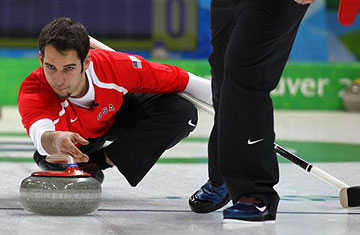
American Jason Smith delivers the stone in a match against Great Britain in a men's curling event on Feb. 21, 2010
When German curling skip Andy Kapp yells at his teammates, imploring them to sweep their brooms faster, he sounds as if someone has poured scorching-hot water on his head. "Arrrgh!" his grunts echo throughout the Vancouver curling venue. "Push," he yells in German. "Hard! Fast!" In curling, the skip's job is to tell his teammates where to throw their stones to the house, that dartboard-looking scoring area on the ice (an explanation of how curling works requires a textbook — just know that in the end, if your stone is closest to the bull's-eye, that's a good thing). And of course, he also badgers the sweepers.
On Monday morning, the wild screaming from Kapp paid off, as Germany beat China 7-6. "You can call it Bavarian style," Kapp says of his drill sergeant–on-steroids rage. "To a skip, you can only get our emotional way with yelling. Because as a sweeper, you can put your emotion into the broom. I cannot check somebody like in hockey. So where to go with my emotions?"
During curling's run in the Olympics every four years, much of the sports-viewing world gets either strangely addicted or totally bemused by watching the old guys push stones and sweep brooms in what often looks like shuffleboard on ice. But at this year's event, emotions seem to be at an all-time high. Every day, capacity crowds of 5,600 are filling the Vancouver Olympic Centre, mostly to cheer on Canada, home to 729,000 of the 1.1 million curlers around the globe. The atmosphere is even more electric than the scenes in arenas for other sports, like figure skating. That high level of interest extends to the online world; curling has been the most searched Olympic sport on Yahoo! this week, according to the company.
There are two sports in which the Canadians expect nothing less than gold: hockey and curling, and not necessarily in that order. So why is curling a Canadian obsession? "Because we have winter," says Bill Holder, a grain farmer from Kenaston, Sask., who has been curling for 40 years. Though the game began in 16th century Scotland, Holder explains how curling caught on in the prairies of western Canada; essentially, he says, there was nothing else to do. In Canada, the shiny bald dome of Kevin Martin, 43, the Canadian men's curling skip, might as well be this year's Olympic emblem. Since curling receives so much coverage on Canadian television, and the teams often play long games — more than two hours, twice a day — you're bound to catch a glimpse of Martin calling shots at some point.
According to the parents of the American players, however, the rowdy Canadian fans might be taking things a bit too far. "I don't like when they cheer a missed shot," says Glen Isaacson, while watching his son Chris and his teammates fall to Canada 7-2 on Monday. "It violates curling etiquette. That's the part that makes it tough to watch."
A certain pair of pants is also making the sport tough to watch. The Norwegian men's team is sporting garish red, white and blue harlequin-looking trousers that make golf attire look swank by comparison. The slacks have generated so much attention that as the Norwegian team was walking off the ice after destroying France 9-2 on Monday, a Canadian fan asked if he could buy them right from the players. The Norwegians declined, preferring not to enter the post-game interview area in their undies. "We knew it was going to get a lot of attention," says Norwegian curler Haavard Vad Petersson, when asked about his team's sartorial selection. "But maybe a little more than expected. We're actually looking for different colors for a long time. But for a curler, it's always important to have comfy pants."
Sporting white shirts and black bottoms, the U.S. men's team looked fine. The problem was that they played lousy (the American women, at 2-5, are faring no better). After winning a bronze medal as a member of the 2006 U.S. team, John Shuster, who works as a bartender on a northern Minnesota golf course, decided he wanted to captain his own team.
The team's success in Turin, Italy, carried expectations into these Olympics, but after Shuster missed three big shots in U.S. losses to start the tournament, he was benched, giving curling a rare mini-controversy. Alternate Chris Plys entered the lineup, and the U.S. beat France 4-3 for its first win. Strangely, Plys was back on the bench the next day, and though the Americans won that game too, they finished the tournament 2-7, way out of medal contention.
Plys, who has attracted a minor Internet following because of his sharp looks (one site dubbed him "Olympic Stud of the Day"), can't completely hide his disappointment in not getting more ice time. "It's frustrating, yeah," he says. "It is what it is." As the youngest member of the U.S. team — he's 22 — and the alternate, Plys insists that he is in no position to plead his case with his coaches.
Perhaps that German skip can teach Plys to speak up.
